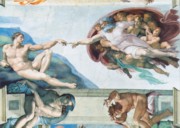
ROME – TOUR OF THE VATICAN MUSEUMS AND THE SISTINE CHAPEL FOR DISABLED (2 HOURS)
Details
TWO-HOUR TOUR OF THE VATICAN MUSEUMS WITH THE SISTINE CHAPEL FOR DISABLED
|
DURATION: | 2 hours | |
|
PRICE: | Based on the number of participants | |
|
AVAILABILITY: |
All-year-round |
THE PRICE INCLUDES: |
Local English-speaking Guide for the 2-hour visit of the Vatican Museums and the Sistine Chapel in Rome THE ENTRANCE FEES ARE NOT INCLUDED |
This tour route, designed specifically for the disabled, is completely step-free. To avoid the stairs situated in the Vatican Museums and near the Sistine Chapel You will use a combination of elevators, ramps, and wheelchair lifts.
Meeting with the English-speaking guide in the prearranged meeting-point:
This tour will show you the most significant religious and cultural areas of the Vatican Museums: The Museum of Pio Clementino, the Galleries of the maps and of the Tapestries, the Rooms of Raphael and finally the Sistine Chapel.
The Vatican Museums are exceptionally important because of the richness and prestige of the masterpieces brought together under various popes over the centuries, as well as for their sumptuous setting. The museums are made up of a group of grand buildings and countless rooms, salons, museums, galleries, libraries, chapels, corridors, courtyards and gardens rich with art treasures of every type. From the Renaissance on, there was not a great artist who did not leave the immortal mark of this genius here.
Between 1475 and 1483, Sixtus IV commissioned Giovanni de’ Dolci to built the Sistine Chapel. He wanted this essential building to be architecturally isolated, virtually inaccessible from the exterior, as it were fortified. Its decoration was begun in 1482 and it transformed the severe, almost bare chapel into a precious picture gallery of 15th – and 16th century Italian Renaissance painting. It was Pope Sixtus IV himself who commissioned some of the best painters of the time such as Perugino, Botticelli, Ghirlandaio and Cosimo Rosselli to illustrate the parallel narratives of the Old and new Testaments which face one another on the central strip of both walls.
In 1508, Julius II, ever eager for new enterprises, ordered the young Michelangelo to paint the ceiling of the Sistine Chapel. The gigantic work began in May 1508 and was completed on All Souls Day 1512. The immense challenge posed by the vast size of the surface of the vault to be covered (an area of at least 800 square meters) and its bareness was brilliantly overcome by Michelangelo with an ingenuity that reveals the rich complexity of his artistic genius. In fact, he covered the actual architecture by painting over it an architectural structure in which he set the various figurative elements with an amazing three-dimensional effect. The artist incomparably combined painting, sculpture and architecture, making the most of the curves of the vault to fit his powerful figures into the scenes.
A good 23 years passed, during which the Christian world was torn apart by the Lutheran Reformation and Rome suffered the terrible Sack of 1527, before Michelangelo painted the Last Judgement on the wall behind the main altar. This unique masterpiece is overwhelming and dominated by the splendid audacity of its author who put his whole self into it.
Between 1980 and 1994 a large-scale restoration of the frescoes on the ceiling and the Last Judgement was carried out and attracted keen attention all over the world. In fact, by dissolving the heavy layers of dust and lamp-black deposited on the paintings with the passing of centuries and the clumsy attempts at restoration with animal glues in the 17th century, somewhat unexpectedly this in-depth cleansing brought the most brilliant colours to light, which has led some experts to revise the theory of the prevalence of drawing over the use of colour in Michelangelo’s painting.












